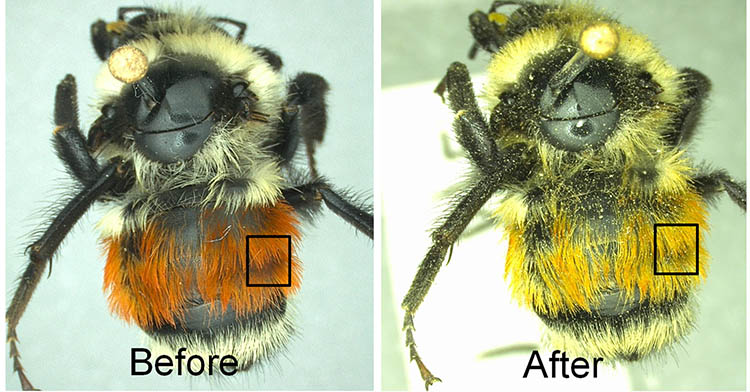The effect of photobleaching on bee (Hymenoptera: Apoidea) setae color and its implications for studying aging and behavior
DOI:
https://doi.org/10.17161/jom.v0i38.4737Keywords:
Bombus, Melecta, Osmia, photobleaching, integumentAbstract
Historically, bee age has been estimated using measurements of wing wear and integument color change. These measurements have been useful in studies of foraging ecology and plant-pollinator interactions. Wing wear is speculated to be affected by the behaviors associated with foraging, nesting, and mating activities. Setal color change may be an additional parameter used to measure bee age if it is affected by sun exposure during these same activities. The objectives of this study were to experimentally assess the effect of direct sun exposure on setal color, unicellular hair-like processes of the integument, and determine whether wing wear and integument photobleaching are correlated. To quantify photobleaching of setae, we measured changes in hue of lab-reared Bombus huntii Greene (Apidae) exposed to natural sunlight. We found that sun exposure was a significant variable in determining setal bleaching. To assess the relationship between wing wear and setal photobleaching, we scored wing wear and measured setal hue of B. huntii, Melecta pacifica fulvida Cresson (Apidae), and Osmia integra Cresson (Megachilidae) from museum specimens. Wing wear and setal hue values were positively correlated for all three species; however, the strength of the relationship varies across bee species as indicated by correlation coefficient estimates. Our results suggest that setal color change is affected by sun exposure, and is likely an accurate estimate of bee age. We suggest that future investigations of bee aging consider a suite of morphometric characteristics due to differences in natural history and sociobiology that may be confounded by the use of a single characteristic.
Metrics
References
Cartar, R.V. 1992. Morphological senescence and longevity: An experiment relating wing wear and life span in foraging wild bumble bees. Journal of Animal Ecology 61(1): 225–231.
Davis, A.K., N. Cope, A. Smith, & M.J. Solensky. 2007. Wing color predicts future mating success in male monarch butterflies. Annals of the Entomological Society of America 100(2): 339?344.
Gordon, D.M. 2003. Life history and nest biology of the mason bee Osmia (Acanthosmioides) integra Cresson in coastal dunes (Hymenoptera: Megachilidae). The Pan-Pacific Entomologist 79(1): 45–53.
Hedenström, A., C.P. Ellington, & T.J. Wolf. 2001. Wing wear, aerodynamics and flight energetics in bumblebees (Bombus terrestris): An experimental study. Functional Ecology 15(4): 417–422.
Higginson, A.D., & C.J. Barnard. 2004. Accumulating wing damage affects foraging decisions in honeybees (Apis mellifera L.). Ecological Entomology 29(1): 52–59.
Hines, H.M. 2008. Bumble Bees (Apidae: Bombus) Through the Ages: Historical Biogeography and the Evolution of Color Diversity. PhD dissertation, University of Illinois; Champaign-Urbana, IL; 157 pp.
Hurd, P.D., Jr., & E.G. Linsley. 1951. The melectine bees of California (Hymenoptera: Anthophoridae). Bulletin of the California Insect Survey 1(5): 119 –140.
Kimball, S., P. Matthis, & GIMP Development Team. 2012. GIMP v2.8.2 GNU Image Manipulation Program.
Korytowski, W., & T. Sarna. 1990. Bleaching of melanin pigments. Role of copper ions and hydrogen peroxide in autooxidation and photooxidation of synthetic dopa-melanin. Journal of Biological Chemistry 265(21): 12410–12416.
Kettlewell, H.B.D. 1965. Insect survival and selection for pattern. Science 148(3675): 1290–1296.
Lozier, J.D., J.P. Strange, & J.B. Koch. 2013. Landscape heterogeneity predicts gene flow in a widespread polymorphic bumble bee, Bombus bifarius (Hymenoptera: Apidae). Conservation Genetics 14(5): 1099–1110.
Michener, C.D., E.A. Cross, H.V. Daly, C.W. Rettenmeyer, & A. Wille. 1955. Additional techniques for studying the behavior of wild bees (I). Insectes Sociaux 2(3): 237–246.
Michener, C.D. 2007. The Bees of the World [2nd Edition]. Johns Hopkins University Press; Baltimore, MD; xvi+[i]+953 pp., +20 pls.
Mitchell, T.B. 1962. Bees of the Eastern United States [Volume 2]. North Carolina Agricultural Experiment Station [Technical Bulletin No. 152]; Raleigh, NC; 557 pp.
Mueller, U.G., & B. Wolf-Mueller. 1993. A method for estimating the age of bees: Age-dependent wing wear and coloration in the wool-carder bee Anthidium manicatum (Hymenoptera: Megachilidae). Journal of Insect Behavior 6(4): 529?537.
Rodd, F.H., R.C. Plowright, & R.E. Owen. 1980. Mortality rates of adult bumble bee workers (Hymenoptera: Apidae). Canadian Journal of Zoology 58(9): 1718–1721.
Ruttner, F. 1988. Biogeography and Taxonomy of Honeybees. Springer-Verlag; Berlin, Germany; xii+284 pp.
Sandhouse, G.A. 1939. North American bees of the genus Osmia (Hymenoptera: Apoidea). Memoirs of the Entomological Society of Washington 1: 1–167.
SAS Institute Inc. 2011. Base SAS® 9.3 Procedures Guide. Cary, NC.
Strange, J.P. 2010. Nest initiation in three North American bumble bees (Bombus): Gyne number and presence of honey bee workers influence establishment success and colony size. Journal of Insect Science 10(130): 1–11.
Thorp, R.W., D.S. Horning, Jr., & L.L. Dunning. 1983. Bumble bees and cuckoo bumble bees of California (Hymenoptera: Apidae). Bulleting of the California Insect Survey 23: 1–79.
Published
Issue
Section
License
Copyright for articles published in Journal of Melittology is retained by the authors, with first publication rights granted to the journal. By virtue of their appearance in this open access journal, articles are free to use, with proper attribution and permission of the authors, in educational and other non-commercial settings.





